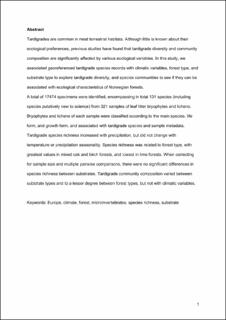| dc.contributor.author | Guidetti, Roberto | |
| dc.contributor.author | Jönsson, K. Ingemar | |
| dc.contributor.author | Kaczmarek, Łukasz | |
| dc.contributor.author | Meier, Terje | |
| dc.contributor.author | Speed, James David Mervyn | |
| dc.contributor.author | Prestø, Tommy | |
| dc.contributor.author | Stur, Elisabeth | |
| dc.contributor.author | Topstad, Lasse | |
| dc.contributor.author | Cesari, Michele | |
| dc.contributor.author | Roszkowska, Milena | |
| dc.contributor.author | Zawierucha, Krzysztof | |
| dc.contributor.author | Hassel, Kristian | |
| dc.contributor.author | Ekrem, Torbjørn | |
| dc.date.accessioned | 2024-02-05T12:32:11Z | |
| dc.date.available | 2024-02-05T12:32:11Z | |
| dc.date.created | 2023-12-15T15:21:52Z | |
| dc.date.issued | 2023 | |
| dc.identifier.citation | Zoological Journal of the Linnean Society. 2023, . | en_US |
| dc.identifier.issn | 0024-4082 | |
| dc.identifier.uri | https://hdl.handle.net/11250/3115610 | |
| dc.description.abstract | Tardigrades are common in many terrestrial environments and habitats. Although little is known on their ecological preferences, previous studies found diversity and community composition significantly affected by various variables. This study associated tardigrade species’ records with climatic variables, forest type, and substrate categories exploring tardigrade diversity and species communities to find associations with ecological characteristics of Norwegian forests. A total of 17 473 specimens were identified, encompassing 131 species (including putatively new species) from 305 samples of different substrates (leaf litter, bryophytes, and lichens). Bryophytes and lichens of samples were classified according to the main species, and growth form, and associated with tardigrade species and sample metadata. Tardigrade species’ richness was related to climatic variables and forest type, increased with precipitation, decreased with summer temperature, and not varied with precipitation seasonality. Although there was an unbalanced representation of substrate categories in the different forest types, some tendencies were detectable. Mixed oak and birch forests reached the highest species’ richness. Tardigrade community composition varied between substrate categories and, to a lesser degree, between forest types, but not with climatic variables. Our study highlights the importance of large-scale variables on tardigrade diversity, and substrate categories for tardigrade community composition. | en_US |
| dc.description.abstract | Tardigrade diversity and community composition across Norwegian boreal forests | en_US |
| dc.language.iso | eng | en_US |
| dc.publisher | Oxford University Press | en_US |
| dc.rights | Navngivelse 4.0 Internasjonal | * |
| dc.rights.uri | http://creativecommons.org/licenses/by/4.0/deed.no | * |
| dc.title | Tardigrade diversity and community composition across Norwegian boreal forests | en_US |
| dc.title.alternative | Tardigrade diversity and community composition across Norwegian boreal forests | en_US |
| dc.type | Peer reviewed | en_US |
| dc.type | Journal article | en_US |
| dc.description.version | acceptedVersion | en_US |
| dc.source.pagenumber | 16 | en_US |
| dc.source.journal | Zoological Journal of the Linnean Society | en_US |
| dc.identifier.doi | 10.1093/zoolinnean/zlad136 | |
| dc.identifier.cristin | 2214242 | |
| dc.relation.project | Artsdatabanken: 70184237 | en_US |
| cristin.ispublished | true | |
| cristin.fulltext | postprint | |
| cristin.qualitycode | 1 | |

